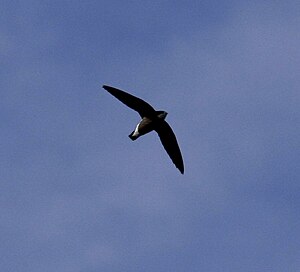Hirundapus
| Hirundapus | ||||||||||
|---|---|---|---|---|---|---|---|---|---|---|

White-throated needletail ( Hirundapus caudacutus ) |
||||||||||
| Systematics | ||||||||||
|
||||||||||
| Scientific name | ||||||||||
| Hirundapus | ||||||||||
| Hodgson , 1837 |
Hirundapus is a genus of birdsinthe sailor family (Apodidae). The common name Asian tall ship issometimes used in German for this genus. The four species of the genus are large to very large sailors. The distribution area includes areas in the east and south-east of Asia and Oceania . Two species are migratory birds , the other two are predominantly resident birds .
The spiny-tailed sailor belonging to this genus is considered to be the fastest sailor, possibly even the fastest bird in the world, with a top speed of 170 km / h in horizontal flight.
features
The body length of the two larger species is 25 centimeters, the purple swift is the largest sailor in the Old World . The two smaller species, the spiny-tailed and gray-throated swift , are still relatively large with a body length of 20 centimeters. All species of the genus have a very shiny plumage and show a light horseshoe pattern on the underside, which is formed by the light under tail coverts and the light stripes on the flanks and forms a clear contrast to the surrounding darker plumage. The sexes look the same.
The body shape of the representatives of the genus is also characteristic: the long wings are broad at the base, almost triangular and the fletching on the arm wings is very dense. The head is relatively large and is stretched forward. The broad, relatively short tail is cut straight or slightly rounded. The length of the "tail spines", the quills protruding over the tail of the tail feathers , is quite different, with the two smaller species showing rather inconspicuous and thin tail spines, the larger species wider.
Systematics
Sibley & Monroe divided the genus into two superspecies , whereby the two smaller and the two larger species of the genus each form a superspecies: the caudacutus superspecies form spiny-tailed and gray-throated swifts , the giganteus superspecies common swift and purple swift. The earlier view that the species of these two superspecies were conspecific was refuted by Collin and Brooke in 1976.
The following species are included in the genus:
- White-throated needletail ( Hirundapus caudacutus )
- Gray-throated swift ( Hirundapus cochinchinensis )
- Fast swift ( Hirundapus giganteus )
- Purple Swift ( Hirundapus celebensis )
literature
- Phil Chantler, Gerald Driessens: A Guide to the Swifts and Tree Swifts of the World. Pica Press, Mountfield 2000, ISBN 1-873403-83-6
- del Hoyo, Elliot, Sargatal (Eds.): Handbook of the Birds of the World. Volume 5: Barn-Owls to Hummingbirds. Lynx Edicions, 1999, ISBN 84-87334-25-3
Individual evidence
- ↑ This and all information not specially marked are taken from the following source: A Guide to the Swifts and Tree Swifts of the World . Page 172, see literature
- ↑ del Hoyo et al. (1999): Handbook of the birds of the world . Page 390, see literature
- ↑ thetravelalmanac.com: The world's fastest birds
- ↑ Chantler, Driessens: A Guide to the Swifts and Tree Swifts of the World . Page 24, see literature
Web links
- Hirundapus on the IUCN Red List of Threatened Species.